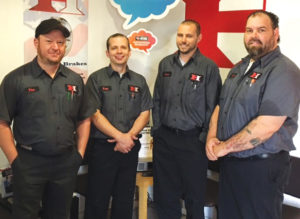 Fall is a traditional time to make sure your vehicle is ready for the winter months ahead.
Fall is a traditional time to make sure your vehicle is ready for the winter months ahead.
We may have some mild winters here in the Valley, but the conditions still are completely different from the summer. You should always have a complete inspection performed on your car during service, but fall is one of the most important times. Your car has just been through extreme heat and storms.
Here are some key areas on which to focus:
Tires—Tires should be checked for wear, dry cracking and, of course, air pressure. Always turn your front tires out when performing the inspection. The outside edge may look just fine, but it may be a whole different story when you check the inside edge. Poor alignment will contribute to the tires not wearing evenly across the tread. Closely inspect the sidewall of the tire for dry cracking. Tires more than five years old should be replaced or they may separate. Tire pressure should be checked every few months.
Fall is an important time because of the temperature change. Air pressure goes down 1psi for every six degrees of air temperature. If your car tire pressure was set when the temperature was 110 degrees, that same tire will lose 7psi when the temp is 70 degrees. Tire monitoring systems are great, but not foolproof. Sometimes, the system only is looking for a large difference between tire pressures and not just low tire pressure. If your tires have been rotated, your system may show a low tire on the right front but the actual low tire may be in a different position. Always check all four tires when your low tire light comes on.
Battery—Batteries take a beating during the summer, and there is a high rate of failure once the weather starts to cool again. It is best to test a battery after your vehicle has been parked for at least an hour. A battery will give a false reading if it recently was driven due to the charge voltage from the alternator. A dead battery is never convenient. So, make sure you change it at the first sign of trouble. The cable ends should also be checked often for signs of corrosion. If corrosion goes unattended, it can damage the cable.
Belts and Hoses—Have your vehicle’s belts and hoses inspected to ensure their reliability. Engine belts don’t always show visual cracks when they are worn. A depth gauge needs to be used to measure the ribs for proper gripping. When checking hoses, make sure all the hoses are checked. There are radiator, heater, and in most cases, other hoses that can be found all around the engine compartment. It only takes one small hose failure to cause an overheating situation that can lead to expensive repairs.
Vehicle Health—A complete inspection of the entire vehicle should be performed. This includes fluids, braking system, suspension, filters and steering. Any component on the car made of rubber is susceptible to dry rotting with our extreme heat and dryness. Being proactive when a problem is first discovered can alleviate a costly breakdown in the future.
Just like changing oil, the other fluids become contaminated and lose their protective and lubricating ability. Following recommended service intervals for fluid changes will help prevent failure of those systems.
For more information, call H and I Automotive at (480) 985-9279. We are a full service professional automotive service center, serving our East Valley neighbors since 2009. Find us online at handiautomotive.com or on Facebook and Google+.

